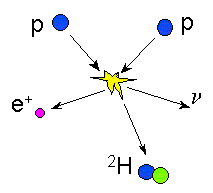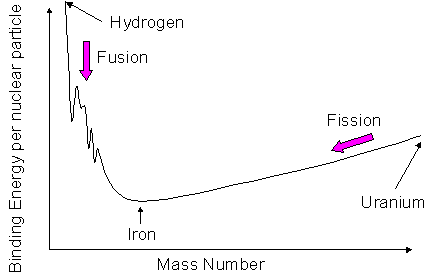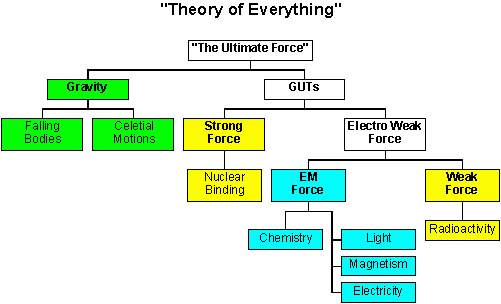|
Lecture 6: The Nature of Light
|
|
Astronomy 101/103 |
Terry Herter, Cornell
University
|
|

Lecture
Goals
|
Cosmic forces (forces of Nature)
-
The
four fundamental forces (Gravity, E-M, Strong, and Weak)
-
GUTs and TOEs
Light
-
Wavelength and Frequency
-
The
E-M Spectrum
-
Light and Energy
|
|
|
Forces of
Nature
|
The four fundamental forces of nature are:
|
Force |
Relative Strength |
Comment |
|
Nuclear |
1 |
Holds nuclei together |
|
Electromagnetic |
1/137 |
Holds atoms, molecules, our bodies, etc. together
|
|
Weak |
10-13 |
Responsible for radioactive decay of certain particles
|
|
Gravitational |
10-39 |
Holds planets together, governs evolution of the
universe, etc. |
|
Your everyday experience is with Electromagnetic and
Gravitational Forces.
|
|
|
E-M
Forces
|
-
Allows us to exist (among other things).
-
Hold us together, make blood flow, make molecules form, etc.
-
Very strong
|
The EM force can be either attractive or repulsive |
|
Unlike charges attract
|
|
|
(+)==>
|
<==(-) |
|
Like charges repel
|
|
|
<==(+)
|
(+)==> |
|
<==(-)
|
(-)==> |
|
|
|
Light
|
What is light?
Light is an electromagnetic (EM) wave propagating through space.
EM
waves (photons) include:
-
ultraviolet radiation
-
visual light
-
infrared radiation
-
radio waves, etc.
|
Aside [In case you are interested]:
|
Light is a transverse wave. This means that the
oscillation is perpendicular to the direction of
motion (much like a water wave).
So what causes light to exist and move? In physics it
is known that a changing magnetic field causes a
changing electric field (and visa versa). A photon
consists of a time varying electric and magnetic field
which regenerate each other! As far as we know this
will go on forever unless the photon gets absorbed (by
an atom or collection of atoms).
|
|
|
|
|
The Colors
of Light
|
|
Isaac Newton determined that when light passes through a PRISM (see
below), it disperses into various "colors".
In
essence, he used a PRISM to make a rainbow, and invented
spectroscopy.
|
"Nature and nature's laws lay hid in the night:
God said, 'Let Newton be!' and all was light."
|
|
... Alexander Pope
|
|
|
|
|
Spectroscopy
|
|
Spectroscopy breaks the light into different (wavelengths) colors.

Rain
drops act as prisms to cause a rainbow.
|
|
|
Wavelength
of Light
|
|
Light is characterized by a wavelength, which is the distance
between two similar points in the wave, e.g. the valleys or peaks.
 |
|
|
Frequency
of Light
|
|
In addition to wavelength, we sometimes talk about the frequency
of a photon.
Let
"c" be the speed of light (3x108 m/s), then we have
|
Relationship between frequency and wavelength
|
|
l
f = c or f = c/l
|
|
where
|
|
|
f
|
= frequency of radiation |
|
l
|
= wavelength of radiation |
|
c
|
= speed of light |
|
What is "frequency"?
-
If
a wave goes by while you are sitting in a boat, you go up and
down at a given rate.
-
This is the frequency of the wave.
-
The
analogy carries over to light waves.
|
|
|
The E-M
Spectrum
|
|
The
electromagnetic spectrum is our "window" to the Universe.
Historically various parts of the E-M spectrum have been given
labels. Some of the most common names are listed below.
|
Radiation |
Approximate Wavelength |
|
|
Angstroms |
Microns |
|
Gamma rays |
0.01 |
10-6 |
|
X-rays |
1 |
10-4 |
|
Ultraviolet |
1000 |
0.1 |
|
Visible |
5000 |
0.5 |
|
Infrared |
105 |
10 |
|
Microwave |
107 |
103 |
|
Radio |
108 |
104 |
|
Radio |
109 |
106 |
|
|
|
|
Why the
Labels?
|
|
The use of labels is partly for convenience and partly historical.
Photons of different energy are usually detected with different
instruments.
-
our
eyes detect visible light
-
radio detect radio waves
|
|
|
Light
and
Energy
|
|
Just like particles, photons carry energy. Each wavelength has a
unique energy given by the expression below (Einstein again!)
Let
"c" be the speed of light (3x108 m/s), then we have
|
Relationship between energy and frequency/wavelength
|
|
|
|
where
|
|
|
h
|
= Planck's constant |
|
|
= 6.626x10-34 |
|
f
|
= frequency of radiation |
|
l
|
= wavelength of radiation |
|
c
|
= speed of light |
|
Long waves, such as radio waves, carry little energy.
Short waves, like X-rays, carry lots of energy.
This is why ultraviolet radiation can give you a sunburn and
cause cancer (see the discussion on the ozone hole below).
|
|
|
Atmospheric
Windows
|
|
Atmospheric windows are locations in the EM spectrum where the
atmospheric is transparent.
The atmosphere only allows certain wavelengths to pass through it.
-
Visible: 3500 - 10000 A
-
Radio: 1 mm - 100 m
This is one reason why astronomers want observatories in space.
|
|
|
The
Ozone
Hole
|
|
Ozone (O3) occurs at an altitude that varies with
latitude and season. The peak concentration in the ozone layer
occurs at about 16 km. However, ozone is present up to about 80
km.
Because it has an absorption band near 3000 A, ozone blocks the
ultraviolet (UV) rays from the sun. Due to their shorter
wavelength (higher frequency), UV photons have more energy than
their optical counterparts. This means that they can damage our
skin, potentially resulting in cancer.
A
breakdown in the ozone layer can not only be harmful to humans but
plant and animal life as well.
|
Aside [In case you are interested]:
|
At shorter wavelengths absorption due to water, atomic
and molecular oxygen, and atomic and molecular
nitrogen blocks UV and X-rays from reaching the earth.
|
|
|
|
|
Forces of
Nature
(Again)
|
The four fundamental forces of nature are:
|
Force |
Relative Strength |
Comment |
|
Nuclear |
1 |
Holds nuclei together |
|
Electromagnetic |
1/137 |
Holds atoms, molecules, our bodies, etc. together
|
|
Weak |
10-13 |
Responsible for radioactive decay of certain particles
|
|
Gravitational |
10-39 |
Holds planets together, governs evolution of the
universe, etc. |
|
Your everyday experience is with Electromagnetic and
Gravitational Forces.
|
|
|
Gravity
|
|
Newton formulated his theory of gravity in 1667
More mass => stronger attraction
Newton's law of gravity is given by:
|

|
|
F = |
Force of attraction (Newtons) |
|
G = |
6.67 x 10-11 m3kg-1sec-2
|
|
m1 , m2 = |
masses (kg) |
|
d = |
distance between objects (m) |
|
In
words, this means that the attractive force between to bodies is
proportional to the produce of their masses. The more massive a
body the stronger the attraction.
In
addition the force gets weaker as you move the bodies further
apart. It decreases as the square of the distance. Doubling the
distance means the force is four times weaker.
|
|
|
Gravity
Examples
|
|
The table below (column 4) shows how much more you would weigh if
you were standing on the "surface" of the various astronomical
bodies.
Examples of Surface Gravity
|
Object |
Mass
(Earth=1) |
Diameter
(Earth=1) |
Gravity
(Earth=1) |
|
Moon |
0.0123 |
0.27 |
0.17 |
|
Venus |
0.81 |
0.95 |
0.91 |
|
Mars |
0.11 |
0.53 |
0.38 |
|
Jupiter |
317 |
11.2 |
2.54 |
|
Sun |
333,000 |
109 |
27.9 |
|
|
Aside [In case you are interested]:
These numbers are derived from Newton's law of gravity
and the force equation F = ma. We typically designate
the acceleration due to gravity with the letter g,
thus a = g. Let your mass (or what every object you
want) be m and the mass of the planet or star be M.
Then g = F/m = GM/d2 gives the gravity.
Rather than looking up the value of G, the
gravitational constant, you can compute everything
relative to the earth (mass, diameter, and gravity).
This is done for the table above. |
|
|
|
|
Nuclear
Force
|
|
-
Holds atomic nuclei together
-
Glues protons and neutrons together
-
Very short range
-
Can release tremendous amount of energy via fusion or fission
-
Nuclear energy
-
Atomic bomb
|
|
|
Energy
and
Matter
|
Einstein showed there is an equivalence between mass and
energy.
1000 kg of matter converted into energy
|
|
|
Energy
from
Fusion
|
 Fusion
is the combination of two or nuclei to form a heavier nucleus. Fusion
is the combination of two or nuclei to form a heavier nucleus.
For
example, fusing Hydrogen into Helium releases energy by the
conversion of mass (since He is less massive than H).
Example chemical reaction
Fusion releases about a million times more energy per reaction.
|
|
|
Nuclear
Fission
|
|
Fission is the breaking up of nuclei
Uranium fission:

Hiroshima Atomic Bomb
|
|
|
Energy
Release
|
|
Energy from Fusion and Fission
Energy is released when elements lighter than iron are fused
together. Likewise energy is released when element heavier than
iron are split apart (fission). Conversely, to fuse heavier
elements or split light elements requires extra energy.
The plot below shows the "binding energy" per nucleon versus mass
number. Iron is the most tightly bound nucleus. This means that
moving towards iron releases energy. It is like a ball rolling to
the lowest point.
 |
|
|
Weak
Force
|
|
The Weak Force is responsible for the radioactive decay of certain
kinds of particles.
The
decay of the neutron is an example of the weak interaction.
n -->
p + e- + n
The neutron decays into a proton, electron, and a neutrino (actually
an antineutrino). The neutrino is very low (perhaps zero) mass
particle that interacts very little with matter. |
|
|
Unified
Theories |
|
The "standard model" of particle physics brings together quantum
chromodynamics (QCD) and electroweak theory. QCD describes the
strong (force) interactions under the hypothesis that all strongly
interacting particles are made of quarks. The electroweak theory
unifies the weak and electromagnetic interactions. Together
general relativity and the "standard model" appear to explain all
known physics.
Unified Theories attempt to bring together our understanding of
physics one step further.
Grand Unified Theories (GUTs)
-
The
strong, weak, and electromagnetic interactions are unified.
-
GUTs have the basic idea that these three forces are really
manifestations of one force. [If we could do experiments at very
high energies (1014 to 1015 GeV) then
there would be one force, not three.]
-
However, even the simplest GUTs have over 20 free parameters (such
as the charge of the electron) that must be determined
experimentally.
-
The
ultimate GUT would have only a few or perhaps no adjustable
parameters.
Theory of Everything (TOE)
-
The
idea behind a TOE to include gravity as well.
-
This would unifies all 4 forces, and perhaps create a theory in
which there are fewer adjustable parameters.
-
This hasn't been done yet
|
|
|
TOEs
|
|
The
tree below shows the hiearchical structure for GUTs and TOEs.
 |
|
|
|



 Fusion
is the combination of two or nuclei to form a heavier nucleus.
Fusion
is the combination of two or nuclei to form a heavier nucleus.

